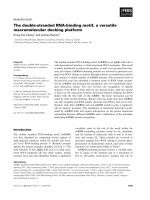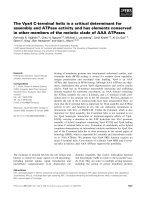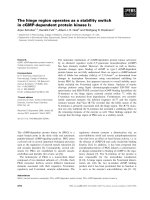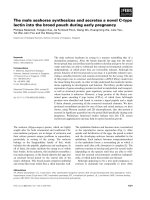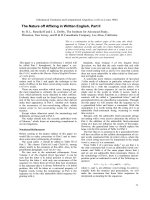Báo cáo khoa học: "The stylomastoid artery as an anatomical landmark to the facial nerve during parotid surgery: a clinico-anatomic study" pptx
Bạn đang xem bản rút gọn của tài liệu. Xem và tải ngay bản đầy đủ của tài liệu tại đây (578.73 KB, 5 trang )
BioMed Central
Page 1 of 5
(page number not for citation purposes)
World Journal of Surgical Oncology
Open Access
Research
The stylomastoid artery as an anatomical landmark to the facial
nerve during parotid surgery: a clinico-anatomic study
Tahwinder Upile*
1,2,3,4
, Waseem Jerjes
3,4,5
, Seyed Ahmad Reza Nouraei
2
,
Sandeep U Singh
2
, Panagiotis Kafas
6
, Ann Sandison
7
, Holger Sudhoff
8
and
Colin Hopper
3,4,5
Address:
1
Department of Otolaryngology/Head and Neck Surgery, Charing Cross Hospital, London, UK,
2
The Ear Institute, University College
London, London, UK,
3
UCLH Head & Neck Centre, London, UK,
4
Department of Surgery, University College London Medical School, London,
UK,
5
Unit of Oral & Maxillofacial Surgery, Division of Maxillofacial, Diagnostic, Medical and Surgical Sciences, UCL Eastman Dental Institute,
London, UK,
6
Department of Oral Surgery and Radiology, School of Dentistry, Aristotle University, Greece,
7
Department of Pathology, Imperial
College & Charing Cross Hospital, London, UK and
8
Department of Otolaryngology, Head and Neck Surgery, Bielefeld Academic Teaching
Hospital, Bielefeld, Germany
Email: Tahwinder Upile* - ; Waseem Jerjes - ; Seyed Ahmad
Reza Nouraei - ; Sandeep U Singh - ; Panagiotis Kafas - ;
Ann Sandison - ; Holger Sudhoff - ; Colin Hopper -
* Corresponding author
Abstract
Background: The identification of the facial nerve can be difficult in a bloody operative field or by
an incision that limits exposure; hence anatomical landmarks and adequate operative exposure can
aid such identification and preservation.
In this clinico-anatomic study, we examined the stylomastoid artery (SMA) and its relation to the
facial nerve trunk; the origin of the artery was identified on cadavers and its nature was confirmed
histologically.
Methods: The clinical component of the study included prospective reviewing of 100 consecutive
routine parotidectomies; while, the anatomical component of the study involved dissecting 50
cadaveric hemifaces.
Results: We could consistently identify a supplying vessel, stylomastoid artery, which tends to vary
less in position than the facial nerve. Following this vessel, a few millimetres inferiorly and medially,
we have gone on to identify the facial nerve trunk, which it supplies, with relative ease. The origin
of the stylomastoid artery, in our study, was either from the occipital artery or the posterior
auricular artery.
Conclusion: This anatomical aid, the stylomastoid artery, when supplemented by the other more
commonly known anatomical landmarks and intra-operative facial nerve monitoring further
reduces the risk of iatrogenic facial nerve damage and operative time.
Published: 28 September 2009
World Journal of Surgical Oncology 2009, 7:71 doi:10.1186/1477-7819-7-71
Received: 8 May 2009
Accepted: 28 September 2009
This article is available from: />© 2009 Upile et al; licensee BioMed Central Ltd.
This is an Open Access article distributed under the terms of the Creative Commons Attribution License ( />),
which permits unrestricted use, distribution, and reproduction in any medium, provided the original work is properly cited.
World Journal of Surgical Oncology 2009, 7:71 />Page 2 of 5
(page number not for citation purposes)
Background
Parotid surgery can at best be tricky and at worst ruinous.
The crux of the matter remains the functional preservation
of facial nerve (FN), through proper identification and
preservation of the nerve at surgery [1].
The identification of the nerve can be difficult in a bloody
operative field or by an incision that limits exposure;
hence the use of anatomical landmarks, careful dissection
with a 'bloodless field' and adequate operative exposure
can aid such identification and preservation (Table 1).
There are many anatomical variations in the position of
the facial nerve. Since on an embryological basis the facial
nerve grows into the developing parotid gland and is sub-
ject to many different anatomical variations that are not
paralleled in branchial artery development. Teleologically
this is an extension of evolutionary principles whereby a
reliable blood supply is required and assured for other
structures to develop around them. Hence one may argue
that arteries or supplying vessels tend to vary in position
less than nerves [2].
Approaches to the parotid gland need therefore to provide
excellent exposure to allow unencumbered identification
and dissection of the facial nerve, and complete excision
of the pathological lesion. The standard approach is via a
cervico-mastoid-facial incision, which provides good
exposure and is relatively easy to perform [3].
In this clinico-anatomic study, we looked at the stylomas-
toid artery (SMA) and its relation to the facial nerve trunk;
the origin of the artery was identified in cadavers and its
arterial nature was confirmed histologically. The artery
traverses the stylomastoid foramen with the facial nerve.
Methods
The study protocol was approved by the local committee
of the ethics for human research.
The clinical component of the study included prospective
observation of 100 consecutive routine parotidectomies,
noting the presence and variations of the stylomastoid
artery. Where the surgical approach permitted in 56 of
those cases (i.e. the posterior belly of the digastric muscle
was dissected), the origin of the stylomastoid artery was
also identified.
An information sheet explaining the aim of our study in
simple non-scientific terms was given to each patient who
was then asked to sign a consent form.
The anatomical component of the study involved dissect-
ing 50 cadaveric hemifaces to assess the surgical anatomy
of the stylomastoid artery; furthermore, the arterial nature
of the vessel was confirmed by histologically.
Intraoperative clinico-anatomical data included: origin of
the stylomastoid artery (SMA), recording the usual posi-
tion and any variation of the facial nerve (FN) and assess-
ing whether the stylomastoid artery was helpful in
identifying the FN (Table 2).
A standard cervico-mastoid-facial incision was employed
in both the clinical and anatomical components of the
study.
Description of the surgical access to the stylomastoid
artery (traditional cervico-mastoid-facial approach)
The consented patient is placed under general anaesthesia
(with hypotension if indicated) and positioned in a
"Reverse Trendelenberg 30°" with the head turned to the
opposite side.
The patient was draped in such a way so that the ear, cor-
ner of the eye, corner of mouth and neck are exposed. We
use an 'opsite
®
' see-through adhesive plastic drape over
the exposed areas and infiltrate the marked skin incision
with a dilute tumescent vasoconstrictor solution.
Bipolar cautery and a working facial nerve stimulator were
used (set at low mA) as part of routine practice. An assist-
ant provided intelligent counter traction, whilst being
aware of pressure induced nerve ischemia.
Table 1: Summary of the most common methods in identifying the facial nerve trunk.
Surface landmarks Intra-operative landmarks Using instruments
• Temporomandibular joint • Retromandibular vein • Use nerve stimulator
• Mastoid process • Tragal pointer • Use of nerve monitor
• Angle of the mandible • Tympanomastoid fissure
• Transverse process of the axis • Styloid process
• Posterior belly of the Digastric
• Retograde dissection of a Peripheral branch to the main trunk
• Temporoparotid facia
• Extension of dissection from the vertical portion of the facial nerve within
the mastoid (diagastric ridge)
n the ctn guageasoconstrictordentified we rarely use diathermy
World Journal of Surgical Oncology 2009, 7:71 />Page 3 of 5
(page number not for citation purposes)
A cervico-mastoid-facial incision is made with a number
10 blade; the incision follows the anterior contour of the
ear then curves gently behind the auricle, and extends
anteriorly at least two of the "patient's fingerbreadths"
beneath the lower border of the mandible. The parotid
flap is raised with sharp iris scissors, with the blades
spread at right angles to the capsule. Dissection continues
to the anterior border of the gland (where the fascia over-
lying the masseter is visible). Posteriorly and inferiorly the
gland is separated from the sternomastoid muscle. One
should try and preserve at least the posterior division of
the greater auricular nerve if oncologically justified. The
parotid is separated from the cartilaginous portion of the
external ear by careful scissor dissection until the tragal
pointer is exhibited.
Haemostasis is achieved using a combination of head up
position, vasoconstrictor solution, fine mosquito clips,
small gauge ties and bipolar cautery. The posterior belly of
the digastric muscle is separated from the gland and fol-
lowed superiorly. The mastoid process is also identified.
Working on a broad front, from below up and behind for-
wards the remaining parotid gland is separated from the
cartilaginous ear, posterior belly of the digastric and mas-
toid tip.
Curved mosquito clips were used to elevate and separate
the tissues before possible division. We often use surgical
magnification to find the small arterial branch which usu-
ally overlies the main trunk of the nerve. The stylomastoid
artery (SMA) is routinely used as a surgical landmark to
identify the FN; this arterial branch may be divided later if
necessary. Depending upon the location of the lesion, we
work across a broad front tracing the facial nerve branches
to the borders of the specimen. The wound is irrigated and
the patient placed in a head down position and an anaes-
thetic Valsalva manoeuvre is carried out. Judicious hae-
mostasis with cautery and ties is carried out before a large
'Haemovac' drain is carefully placed and the incision
closed in layers with absorbable suture to deep tissues.
Cadaveric dissection was performed via a cervico-mas-
toid-facial incision and standard dissection was per-
formed as described above. Clinical and gross anatomical
photography was obtained from a Fujifilm Finepix 2 Meg-
apixel Digital Camera, all surgical instruments were
obtained from the Downs surgical
®
catalogue.
Results
After prospective review of a 100 parotidectomies, we can
consistently identify a supplying vessel, the stylomastoid
artery. Following this vessel, a few millimetres inferiorly
and medially, we have gone on to identify the facial nerve
trunk, which it supplies, with relative ease (Figure 1). This
has potentially shortened the overall mean duration of
the operation however this is not a controlled primary
outcome measure and is purely anecdotal. We would wish
to advocate careful and timely dissection rather than
'rushed' surgery that may jeopardise patient outcomes.
After further cadaveric dissections (50 hemifaces), we
determined this to be the SMA which is known to supply
the facial nerve whilst accompanying it through the stylo-
mastoid foramen. The arterial nature of the vessel was
confirmed histologically.
In 80 of the 100 clinical cases, the SMA was clearly identi-
fied but in only 56 cases was it possible to determine the
origin of stylomastoid artery from either the occipital
artery or the posterior auricular artery during the dissec-
tion. In 8 cases the SMA was unhelpful because of previ-
ous soiling of the operative field with blood. The initial
dissection technique must be meticulous and gentle to
avoid this problem. In the cadaveric study, the post mor-
Table 2: Intraoperative clinico-anatomical data.
Study Identified Origin of SMA
OA:PA
Usual position of
FN
Variable position
of FN
Was the SMA
helpful?
Reasons for the SMA
being unhelpful
Clinical 80 cases 46:10 70% 30% 72/80 Bloody field
Cadaveric 50 cases 42:8 76% 24% 46/50 Poor tissue anatomy
SMA: stylomastoid artery; FN: facial nerve; OA: occipital artery; PA: posterior auricular artery.
Intraoperative dissection: showing stylomastoid artery located just above and superior to the facial nerveFigure 1
Intraoperative dissection: showing stylomastoid
artery located just above and superior to the facial
nerve. Inset shows a magnified view. N: nerve, a: sytlomas-
toid artery.
World Journal of Surgical Oncology 2009, 7:71 />Page 4 of 5
(page number not for citation purposes)
tem changes in 4 specimens precluded location of the
nerve just by using this technique (Table 2). The origin of
the SMA is from one of the posterior branches of the exter-
nal carotid artery that travel along the medial border of
the posterior belly of the digastric muscle (Figure 2). We
believe the vessel to be a minor branch of the occipital
artery (in over three quarters of patients) and less fre-
quently a branch of the posterior auricular artery (in
nearly one quarter of patients) (Figure 3). The existence of
this artery should now be common surgical knowledge.
Discussion
In order to have safe and effective parotid gland surgery,
knowledge of the anatomical landmarks to the facial
nerve is essential. A wide range of landmarks have been
reported in the literature. However, the reliability of these
landmarks is still one of the main concerns since there is
no conclusive evidence that any one landmark is better
than the rest [4-8].
Pereira et al. [5] suggested that external palpable land-
marks can be used to identify the facial nerve trunk
quickly and safely. In a study that involved 40 human
cadavers, they proposed that a centre of a triangle formed
by the temporomandibular joint, the mastoid process and
the angle of the mandible allowed a fast and safe identifi-
cation of the facial nerve and may be of significant help
during surgery around the parotid region. Pather and
Osman [1] evaluated the relation of the surrounding ana-
tomical structures and surgical landmarks to the facial
nerve trunk through a micro-dissection on 40 adult cadav-
ers. Their results showed that the posterior belly of digas-
tric, tragal pointer and transverse process of the axis are
consistent landmarks to the facial nerve trunk.
El-Hakim et al. [4] assessed the accuracy of using surrogate
anatomic structures radiologically to predict the relation
of parotid lesions to the intraparotid facial nerve. The ret-
romandibular vein was identified as being the most accu-
rate structure. Witt et al. [6] carried out a prospective study
of 14 cadaver specimens and 22 live patients comparing
the closest measured distances between tympanomastoid
and posterior belly of the digastric muscle to the facial
nerve. They proved that the tympanomastoid suture is a
significantly closer and less variable anatomic landmark
to the facial nerve than the posterior-superior margin of
the posterior belly of the digastric muscle in parotid sur-
gery.
The SMA enters the skull through the stylomastoid
foramen, an orifice it shares with the egressing facial
nerve. It seems logical therefore to use this relationship to
aid the identification and preservation of the facial nerve
during surgery.
Moreau et al. [7] anatomically dissected 30 facial nerves in
fresh cadavers after arterial casting with red latex to pro-
vide specific information about the arterial-related anat-
omy of the trunk of the facial nerve from the stylomastoid
foramen to its bifurcation. The trunk of the facial nerve
Cadaveric dissection: displaying the stylomastoid artery (SMA) and underlying nerve (VII) located inferiomediallyFigure 2
Cadaveric dissection: displaying the stylomastoid
artery (SMA) and underlying nerve (VII) located infe-
riomedially. Inset shows magnified view with nylon
between nerve and artery. The Mastoid process has been
detached and sternomastoid muscle reflected inferiorly, with
the cut posterior belly of the digastric muscle (PBD) dis-
played. Showing this vessel to be a branch of the occipital
artery (OA).
Cadaveric dissection: showing the stylomastoid artery above the nerve with nylon between; this dissection revealed the artery to be a branch of the posterior auricular arteryFigure 3
Cadaveric dissection: showing the stylomastoid
artery above the nerve with nylon between; this dis-
section revealed the artery to be a branch of the pos-
terior auricular artery.
World Journal of Surgical Oncology 2009, 7:71 />Page 5 of 5
(page number not for citation purposes)
was in proximity to the stylomastoid artery, which origi-
nated from the posterior auricular artery in 70% of the
specimens, from the occipital artery in 20% and directly
from the external carotid artery in 10%. The SMA passed
medially to the trunk of the facial nerve in 63% of the
specimens and laterally in 37%. The main shortcoming of
this very good study was the anatomical nature of the dis-
section rather than the use of the standard surgical
approach which would have allowed direct translation
into clinical practice. Our results differ in that the SMA
appeared to consistently pass lateral to the egress of the
nerve in superficial to deep anterior to posterior surgical
dissections. Some discrepancies can be accounted for by
the fact of the differing nature of the dissections (anatom-
ical versus surgical) with their significantly different head
positions (anatomical rather than standard surgical).
The 8 cases in the clinical part of our study where the land-
mark was not useful are important in showing the diffi-
culty in applying set approaches for any operative
procedure. Due to the nature of the incision and dissec-
tion depending upon the varied pathology in some cases
the surgical field was soiled with blood from the superfi-
cial dissection. This bleeding was not from the SMA but
usually from superficial veins. In these cases using the
SMA as a landmark was less helpful and other landmarks
were used to find the nerve. As any other tool we do not
propose this approach for all situations and circumstances
only that it be in the surgeon's armamentarium to be
employed when appropriate.
The data in this study supports the use of the SMA as a reli-
able landmark for the facial nerve which may potentially
reduce morbidity. By the early identification of the SMA
and by following it infromedially for a few millimetres we
were able to consistently identify the location of the facial
nerve. Identification aids in the preservation of the facial
nerve by preventing inadvertent nerve section.
Since the SMA was found in only 80% of the clinical study
this suggests that this artery may not always be present or
identifiable. As radiologic studies are not always routinely
performed, we used in order of personal preference (the
tympanomastoid suture line, posterior belly of the digas-
tric muscle, retrograde dissection of a peripheral branch of
the facial nerve and tragal pointer). We also regularly use
'loupe' or formal microscopic magnification and a combi-
nation of nerve stimulator and nerve monitors. The sur-
geon needs all the help that can be manifest but nothing
replaces clinical experience aided by anatomical dissec-
tion and helpful initial supervision.
Conclusion
This anatomical aid, the stylomastoid artery, when sup-
plemented by the other more commonly known anatom-
ical landmarks and intra-operative facial nerve
monitoring further reduces the risk of iatrogenic facial
nerve damage and 'potentially' operative time. The draw-
backs of this approach are that it requires early and metic-
ulous attention to haemostasis combined with very gentle
tissue handling. A feature that many traditional more
approaches were not known for.
The surgeon should use as many of the available land-
marks as feasible to perform safe facial nerve surgery. Both
the main trunk and peripheral branches must be identi-
fied and preserved to prevent permanent aesthetic seque-
lae related to facial paralysis.
Competing interests
The authors declare that they have no competing interests.
Authors' contributions
TU, WJ, SARN, SUS designed the study, carried out the lit-
erature research, clinical and anatomic study and manu-
script preparation. AS, HS, CH were responsible for
critical revision of scientific content and manuscript prep-
aration and review. All authors read and approved the
final manuscript.
Consent
Written informed consent was obtained from all of the
patients for publication of these cases and any accompa-
nying images.
References
1. Pather N, Osman M: Landmarks of the facial nerve: implica-
tions for parotidectomy. Surg Radiol Anat 2006, 28(2):170-5.
2. Larrabee WF Jr, Makielski KH: Surgical Anatomy of the Face.
New York: Raven Press; 1993.
3. Ramsaroop L, Singh B, Allopi L, Moodley J, Partab P, Satyapal KS: The
surgical anatomy of the parotid fascia. Surg Radiol Anat 2006,
28(1):33-7.
4. El-Hakim H, Mountain R, Carter L, Nilssen EL, Wardrop P, Nimmo
M: Anatomic landmarks for locating parotid lesions in rela-
tion to the facial nerve: cross-sectional radiologic study. J
Otolaryngol 2003, 32(5):314-8.
5. Pereira JA, Meri A, Potau JM, Prats-Galino A, Sancho JJ, Sitges-Serra
A: A simple method for safe identification of the facial nerve
using palpable landmarks. Arch Surg 2004, 139(7):745-7.
6. Witt RL, Weinstein GS, Rejto LK: Tympanomastoid suture and
digastric muscle in cadaver and live parotidectomy. Laryngo-
scope 2005, 115(4):574-7.
7. Moreau S, Bourdon N, Salame E, Goullet de Rugy M, Babin E, Valdazo
A, Delmas P: Facial nerve: vascular-related anatomy at the
stylomastoid foramen. Ann Otol Rhinol Laryngol 2000,
109(9):849-52.
8. de Ru JA, van Benthem PP, Bleys RL, Lubsen H, Hordijk GJ: Land-
marks for parotid gland surgery. J Laryngol Otol 2001,
115(2):122-5.
